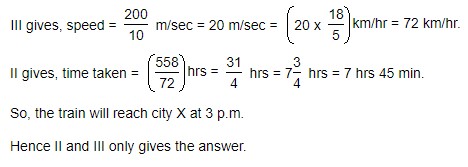Warning: Undefined variable $ext in /www/wwwroot/gkfeed.com/public_html/wp-content/plugins/show-hidecollapse-expand/bg_show_hide.php on line 281
Warning: Undefined variable $ext in /www/wwwroot/gkfeed.com/public_html/wp-content/plugins/show-hidecollapse-expand/bg_show_hide.php on line 281
Directions to Solve
Each of these questions is followed by three statements. You have to study the question and all the three statements given to decide whether any information provided in the statement(s) is redundant and can be dispensed with while answering the given question.
1. At what time will the train reach city X from city Y?
I. The train crosses another train of equal length of 200 meters and running in opposite directions in 15 seconds.
II. The train leaves city Y at 7.15 a.m. for city X situated at a distance of 558 km.
III. The 200 meters long train crosses a signal pole in 10 seconds.
A. I only
B. II only
C. III only
D. II and III only
E. All I, II and III are required.
2. What is the length of a running train P crossing another running train Q?
I. These two trains take 18 seconds to cross each other.
II. These trains are running in opposite directions.
III. The length of the train Q is 180 meters.
A. I only
B. II only
C. III only
D. All I, II and III are required
E. Even with I, II and III, the answer cannot be obtained.
Warning: Undefined variable $in_same_cat in /www/wwwroot/gkfeed.com/public_html/wp-content/plugins/EXP.GKFEED.COM/function.php on line 27
Warning: Undefined variable $excluded_categories in /www/wwwroot/gkfeed.com/public_html/wp-content/plugins/EXP.GKFEED.COM/function.php on line 27

